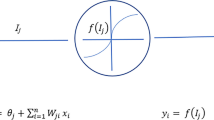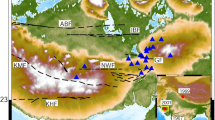Abstract
Topography has a great effect on ground motions, and may aggravate seismic hazards. The quantification of topographic effects is vital for hazard prevention in practice. A series of studies were conducted to achieve this quantification. First, three bell-shaped hills’ numerical models with three input motions for each were established and calculated using finite element method. Second, topographic variables that were closely related to the amplification factors were analysed and selected. Third, back propagation (BP) neural network models using different input variables were tested to quantify the topographic effect. Core methods used in this study were validated using recorded seismic data. The results showed that altitude, slope, aspect, and frequency are important variables that can affect topographic amplification factors. Thin hills or high frequencies of incident waves generally cause great amplification factors at crests. High-frequency waves tend to be captured by small-scale topography and induce amplifications of ground motions at these positions. Altitudes can be positively correlated with amplification factors when wavelengths of incident waves are apparently longer than the dimensions of local topography. Slopes generally do not have a good correlation with amplification factors for low hills until the upper part and lower part of a hill are separated for analysis, owing to slopes at the tops and feet of low hills being very similar. The BP neural network method is adequate for the quantification of the topographic effect. There are at least two combinations of input variables of BP models that can achieve good performance. One combination includes altitude, slope, aspect, and frequency, while the other includes altitude, x-axis gradient, y-axis gradient, and frequency. The former combination is less precise but has better expandability of the predictive region, while the latter combination is more precise but lacks expandability of the predictive region.
















Similar content being viewed by others
Data Availability Statement
This manuscript has associated data in a data repository. [Authors’ comment: The datasets generated during and/or analysed during the current study are available from the corresponding author on reasonable request].
References
S.A. Ashford, N. Sitar, J. Lysmer, N. Deng, Topographic effects on the seismic response of steep slopes. Bull. Seismol. Soc. Am.Seismol. Soc. Am. 87(3), 701–709 (1997). https://doi.org/10.1785/BSSA0870030701
G.A. Athanasopoulos, P.C. Pelekis, E.A. Leonidou, Effects of surface topography on seismic ground response in the Egion (Greece) 15 June 1995 earthquake. Soil Dyn. Earthq. Eng. 18(2), 135–149 (1999). https://doi.org/10.1016/S0267-7261(98)00041-4
D.M. Boore, A note on the effect of simple topography on seismic SH waves. Bull. Seismol. Soc. Am. 62(1), 275–284 (1972)
M. Bouchon, J.S. Barker, Seismic response of a hill: the example of Tarzana, California. Bull. Seismol. Soc. Am. 86(1A), 66–72 (1996). https://doi.org/10.1785/BSSA08601A0066
M. Bouchon, C.A. Schultz, M.N. Toksöz, Effect of three-dimensional topography on seismic motion. J. Geophys. Res. Solid Earth 101(B3), 5835–5846 (1996). https://doi.org/10.1029/95JB02629
G.D. Bouckovalas, A.G. Papadimitriou, Numerical evaluation of slope topography effects on seismic ground motion. Soil Dyn. Earthq. Eng. 25(7–10), 547–558 (2005). https://doi.org/10.1016/j.soildyn.2004.11.008
F. Buech, T.R. Davies, J.R. Pettinga, The little red hill seismic experimental study: topographic effects on ground motion at a bedrock-dominated mountain edifice. Bull. Seismol. Soc. Am. 100(5A), 2219–2229 (2010). https://doi.org/10.1785/0120090345
A.G. Chanda, R. Sahoo, A study on the stress and vibration characteristics of laminated composite plates resting on elastic foundations using analytical and finite element solutions. Eur. Phys. J. Plus 136(11), 1186 (2021). https://doi.org/10.1140/epjp/s13360-021-02090-8
L.L. Davis, L.R. West, Observed effects of topography on ground motion. Bull. Seismol. Soc. Am. 63(1), 283–298 (1973). https://doi.org/10.1785/BSSA0630010283
V. Di Fiore, Seismic site amplification induced by topographic irregularity: results of a numerical analysis on 2D synthetic models. Eng. Geol. 114(3–4), 109–115 (2010). https://doi.org/10.1016/j.enggeo.2010.05.006
X.L. Du, M. Zhao, J.T. Wang, A stress artificial boundary in FEA for near-field wave problem. Chin. J. Theor. Appl. Mech. 38(1), 49–56 (2006). (in Chinese with English Abstract)
Z. Du, J. Liu, Q. Wu, An efficient and accurate strategy of numerical simulation of 2D Rayleigh waves under arbitrary undulating surface conditions. Eur. Phys. J. Plus 137(6), 657 (2022). https://doi.org/10.1140/epjp/s13360-022-02847-9
L. Geli, P.-Y. Bard, B. Jullien, The effect of topography on earthquake ground motion: a review and new results. Bull. Seismol. Soc. Am. 78(1), 42–63 (1988). https://doi.org/10.1785/BSSA0780010042
D.W. Griffiths, G.A. Bollinger, The effect of Appalachian mountain topography on seismic waves. Bull. Seismol. Soc. Am. 69(4), 1081–1105 (1979). https://doi.org/10.1785/BSSA0690041081
S.H. Hartzell, D.L. Carver, K.W. King, Initial investigation of site and topographic effects at Robinwood Ridge, California. Bull. Seismol. Soc. Am. 84(5), 1336–1349 (1994). https://doi.org/10.1785/BSSA0840051336
J. He, S. Qi, Y. Wang, C. Saroglou, Seismic response of the Lengzhuguan slope caused by topographic and geological effects. Eng. Geol. 265, 105431 (2019). https://doi.org/10.1016/j.enggeo.2019.105431
F. Jafarzadeh, M.M. Shahrabi, H. Farahi Jahromi, On the role of topographic amplification in seismic slope instabilities. J. Rock Mech. Geotech. Eng. 7(2), 163–170 (2015). https://doi.org/10.1016/j.jrmge.2015.02.009
H. Kumagai, T. Saito, G. O’Brien, T. Yamashina, Characterization of scattered seismic wavefields simulated in heterogeneous media with topography. J. Geophys. Res. 116(B3), B03308 (2011). https://doi.org/10.1029/2010JB007718
S.-J. Lee, H.-W. Chen, Q. Liu, D. Komatitsch, B.-S. Huang, J. Tromp, Three-dimensional simulations of seismic-wave propagation in the Taipei basin with realistic topography based upon the spectral-element method. Bull. Seismol. Soc. Am. 98(1), 253–264 (2008). https://doi.org/10.1785/0120070033
S.-J. Lee, D. Komatitsch, B.-S. Huang, J. Tromp, Effects of topography on seismic-wave propagation: an example from Northern Taiwan. Bull. Seismol. Soc. Am.Seismol. Soc. Am. 99(1), 314–325 (2009). https://doi.org/10.1785/0120080020
H. Li, Y. Liu, L. Liu, B. Liu, X. Xia, Numerical evaluation of topographic effects on seismic response of single-faced rock slopes. Bull. Eng. Geol. Env. 78(3), 1873–1891 (2017). https://doi.org/10.1007/s10064-017-1200-7
Y. Luo, X. Fan, R. Huang, Y. Wang, A.P. Yunus, H.B. Havenith, Topographic and near-surface stratigraphic amplification of the seismic response of a mountain slope revealed by field monitoring and numerical simulations. Eng. Geol. 271, 105607 (2020). https://doi.org/10.1016/j.enggeo.2020.105607
Y.H. Luo, Y.S. Wang, Mountain slope ground motion topography amplification effect induced by Wenchuan earthquake. J. Mt. Sci. 31(2), 200–210 (2013). (in Chinese with English Abstract)
I.A. Mofor, L.C. Tasse, G.B. Tanekou, M.D. Wamba, R. Kengne, A. Tchagna Kouanou, M.T. Motchongom, D. Afungchui, F.B. Pelap, T.C. Kofane, Dynamics of modulated waves in the spring-block model of earthquake with time delay. Eur. Phys. J. Plus 138(3), 273 (2023). https://doi.org/10.1140/epjp/s13360-023-03863-z
B. Moseley, A. Markham, T. Nissen-Meyer. Solving the wave equation with physics-informed deep learning. arXiv:2006.11894. http://arxiv.org/abs/2006.11894 (2020)
B. Moseley, A. Markham, T. Nissen-Meyer, Finite basis physics-informed neural networks (FBPINNs): a scalable domain decomposition approach for solving differential equations. Adv. Comput. Math. 49(4), 62 (2023). https://doi.org/10.1007/s10444-023-10065-9
A.H. Namadchi, J. Alamatian, Explicit eigenanalysis in structural dynamics using viscous dynamic relaxation method. Eur. Phys. J. Plus 137(10), 1114 (2022). https://doi.org/10.1140/epjp/s13360-022-03333-y
K.-V. Nguyen, B. Gatmiri, Evaluation of seismic ground motion induced by topographic irregularity. Soil Dyn. Earthq. Eng. 27(2), 183–188 (2007). https://doi.org/10.1016/j.soildyn.2006.06.005
A. Pignalosa, G. Forte, P. Budetta, A. Santo, Topographic amplification and debris remobilization as a cause for increasing rockfall hazard in seismic areas: a case study in Central Italy. Geomorphology 403, 108160 (2022). https://doi.org/10.1016/j.geomorph.2022.108160
B. Poursartip, A. Fathi, L.F. Kallivokas, Seismic wave amplification by topographic features: a parametric study. Soil Dyn. Earthq. Eng. 92, 503–527 (2017). https://doi.org/10.1016/j.soildyn.2016.10.031
I. Primofiore, J. Baron, P. Klin, G. Laurenzano, C. Muraro, F. Capotorti, M. Amanti, G. Vessia, 3D numerical modelling for interpreting topographic effects in rocky hills for seismic microzonation: the case study of Arquata del Tronto hamlet. Eng. Geol.Geol. 279, 105868 (2020). https://doi.org/10.1016/j.enggeo.2020.105868
M. Shafique, M. van der Meijde, N. Kerle, F. van der Meer, Impact of DEM source and resolution on topographic seismic amplification. Int. J. Appl. Earth Obs. Geoinf. 13(3), 420–427 (2011). https://doi.org/10.1016/j.jag.2010.09.005
S.M. Sivalingam, P. Kumar, V. Govindaraj, A novel numerical scheme for fractional differential equations using extreme learning machine. Physica A 622, 128887 (2023). https://doi.org/10.1016/j.physa.2023.128887
S.M. Sivalingam, P. Kumar, V. Govindaraj, A novel optimization-based physics-informed neural network scheme for solving fractional differential equations. Eng. Comput. (2023). https://doi.org/10.1007/s00366-023-01830-x
H. Tang, X.J. Li, Y.Q. Li, Site effect of topography on ground motions of Xishan Park of Zigong City. J. Vib. Shock 31(8), 74–79 (2012). (in Chinese with English Abstract)
H.Y. Wang, L.L. Xie, Effects of topography on ground motion in the Xishan park, Zigong city. Chin. J. Geophys. 53(7), 1631–1638 (2010). (in Chinese with English Abstract)
M. Wang, A. Zheng, W. Zhang, Effect of local mountain topography on strong ground motion. Chin. J. Geophys. 60(12), 4655–4670 (2017)
C.B. Wen, F. Ru, Y.Y. Liu et al., Artificial neural network theory and its applications (Xidian University Press, Xi’an, 2021), p.104
H. Zhou, J.T. Li, X.F. Chen, Establishment of a seismic topographic effect prediction model in the Lushan Ms 7.0 earthquake area. Geophys. J. Int. 221(1), 273–288 (2020)
Acknowledgements
We thank Strong Motion Observation Center, Institute of Engineering Mechanics, China Earthquake Administration for providing the acceleration time histories of the mainshock of the Wenchuan earthquake, recorded by the Zigong topographic array. Part of the topographic data were provided by the Geospatial Data Cloud site, Computer Network Information Center, Chinese Academy of Sciences.
Funding
This research was partially supported by Spark Program of Earthquake Sciences (XH24024YC), Special project for cultivating scientific and technological innovation teams of Shandong Earthquake Agency (TD202303), National Key R&D Program of China (2022YFC3003503), Key Projects of Key Laboratory of Urban Security and Disaster Engineering of China Ministry of Education (2023), the Method and Demonstration of Earthquake-landslide Disaster Risk Zonation (Grant No. ZDJ2021-12).
Author information
Authors and Affiliations
Corresponding author
Ethics declarations
Conflict of interest
The authors declare no conflicts of interest.
Rights and permissions
Springer Nature or its licensor (e.g. a society or other partner) holds exclusive rights to this article under a publishing agreement with the author(s) or other rightsholder(s); author self-archiving of the accepted manuscript version of this article is solely governed by the terms of such publishing agreement and applicable law.
About this article
Cite this article
Jiang, Q., Wei, W., Xu, H. et al. A novel seismic topographic effect prediction method based on neural network models. Eur. Phys. J. Plus 138, 1032 (2023). https://doi.org/10.1140/epjp/s13360-023-04662-2
Received:
Accepted:
Published:
DOI: https://doi.org/10.1140/epjp/s13360-023-04662-2




